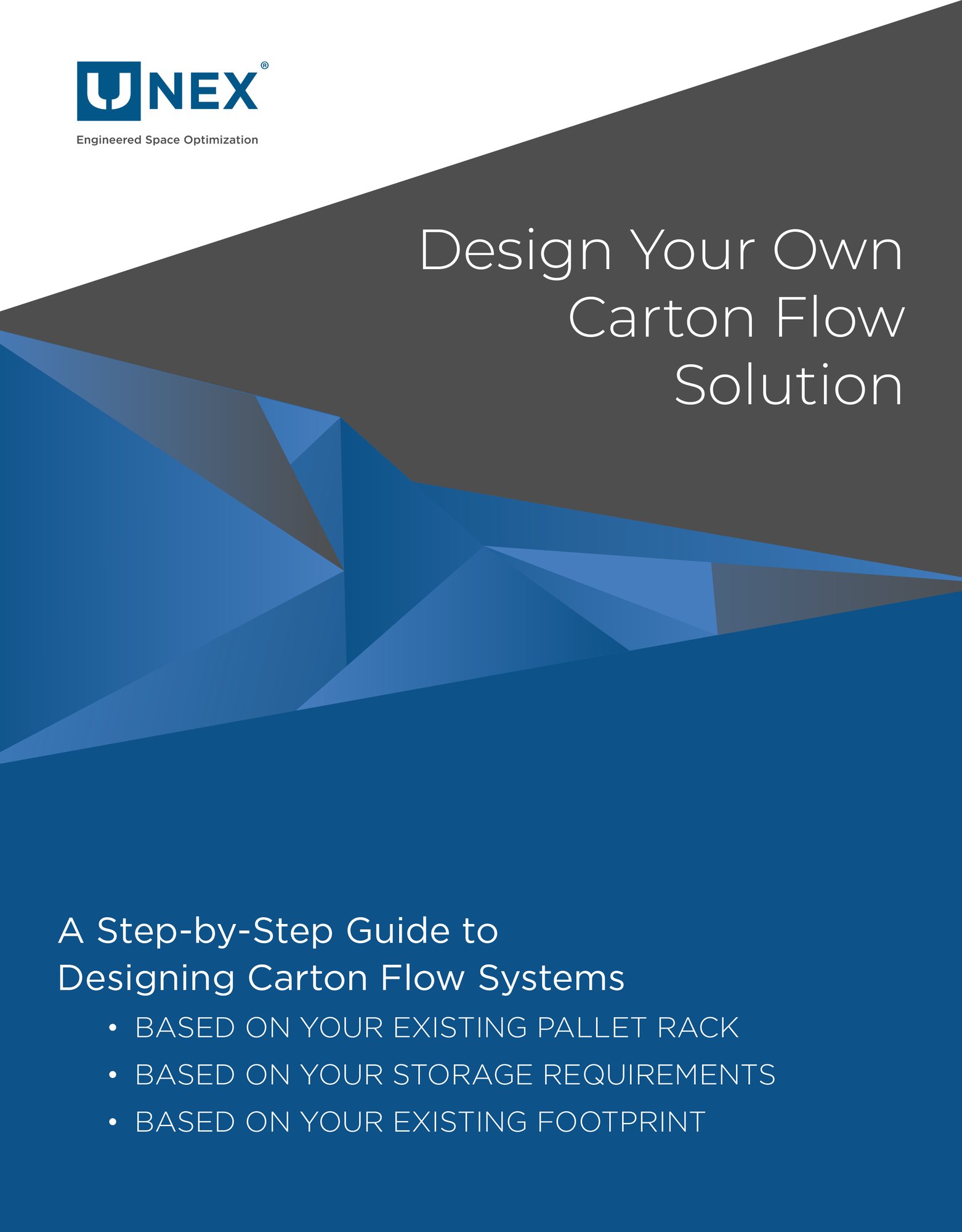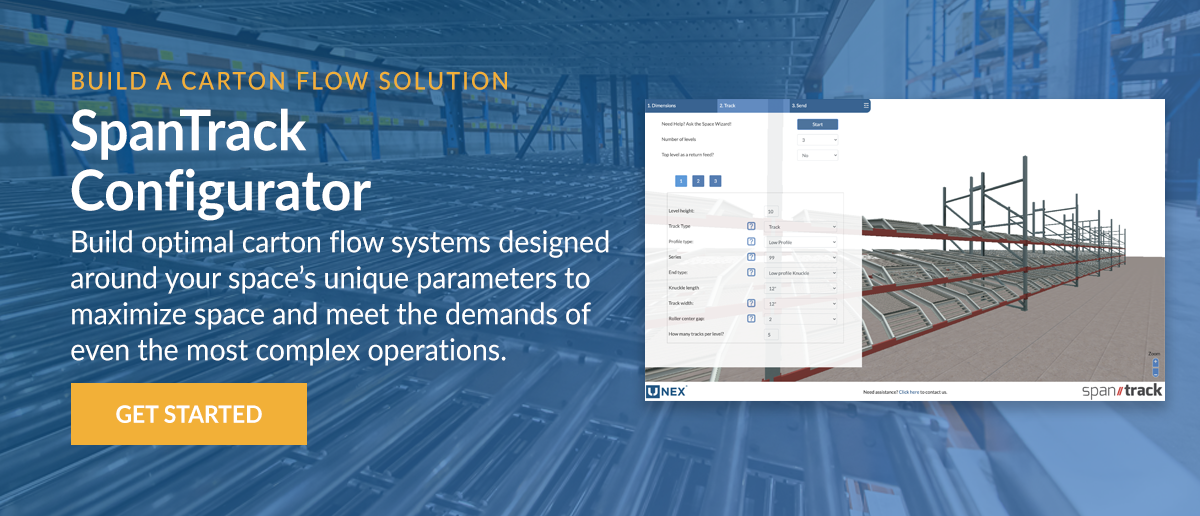DIY Carton Flow for Existing Pallet Rack
In most fulfillment and warehouse facilities, the operation begins with storing products, or SKUs, on industrial pallet racking. However, as you optimize your operation for speed, accuracy, and storage density, you’ll need to incorporate carton flow solutions to maximize space utilization, and ultimately, reach your goals.
Before you start your search for an off-the-shelf solution, did you know you can analyze your own operation and design your own carton flow solution based on your unique needs? All you’ll need is a tape measure, a calculator, and a little help from us.
In this article, we’ll cover the step-by-step process of designing a DIY carton flow system that will reduces pick times, reduce travel times, and dramatically improve the efficiency of your operation.
3 Steps to Optimize Your Space with Carton Flow for Existing Pallet Racks
1. Determine your pallet rack details.
Not all pallet racks are created equal. While pallet racking may seem like a commodity product, every rack manufacturer's process results in slightly different finished products that aren’t always interchangeable. It’s important to keep your equipment consistent as your business grows. Understanding the specifics of your current pallet rack will help you determine how many additional beams you need.
Once you familiarize yourself with your rack manufacturer, you’ll need to focus on three additional items:
- Dimensions
Your length, width, and depth are crucial specifications you need to measure to design your own carton flow system. At certain depths, most carton flow tracks will need to be supported by an intermediary beam. Without properly measuring your dimensions and making appropriate design decisions, you’ll likely invest in a carton flow product that will fail after extended use. - Beam Style
Different pallet rack uprights require different styles of beams. They come in three different styles: structural, step, or box beams. Step and box beams are roll-formed and welded shapes, while structural beams are made from “C” channels. Structural beams typically feature a bolted connection to the pallet rack uprights, while roll-formed beams feature a tear-drop-shaped drop-in connection to the uprights. This is important for two reasons: Beams are secured to uprights through different methods - securing the wrong beam to the wrong upright can create a major safety hazard. Also, the type of beam informs the type of hanger you need to mount carton flow lanes or beds in your pallet rack. Make sure to note the beam style and the manufacturer when taking all your measurements. - Weight Capacities
Industrial pallet rack is typically very sturdy equipment, but just like beam styles, many manufacturers have racks with different weight capacities - and capacities can change depending on the width of the beams you need. Capacity is typically expressed in pounds per pair of beams and assumes the weight is evenly distributed across the beams. While you can always get shorter or longer beams, make sure you know the weight of the products you’ll be placing on them, and ensure your beams can handle it.

2. Analyze your SKUs to determine track requirements.
Once you’ve measured your dimensions and consulted with your rack manufacturer’s documentation to confirm beam styles and weight capacities, you can begin to analyze the throughput of your SKUs. The design of your carton flow system depends on your volumetric throughput - the rate of production or the speed at which something is processed. Building a carton flow solution without analyzing throughput could mean not having enough space to store your SKUs, or buying more or fewer carton flow lanes or wheel beds than you really need.
How to measure volumetric throughput:
- Identify the number of times a SKU is picked in a shift and multiply it by the volume of the SKU - this will determine how much physical space your inventory of that specific SKU occupies.
- Divide that number by your time frame for replenishment - this can be a shift, a day, or even a week.
- Your final number represents your volumetric throughput for a given SKU.
Once you’ve analyzed your entire inventory this way, you can use this information to determine more specifications for your ideal carton flow system, including:
- Type of carton flow
There are several different types of carton flow on the market. Some of the most common include roller lanes, wheel beds, and plastic wheel rails. UNEX offers SpanTrack Lane (dedicated lanes) and SpanTrack Wheel Bed (universal wheel beds). Your throughput will help you better understand the variation of your SKU dimensions and which SKUs move quicker than others. This informs the type of carton flow solution you need - the more variation in dimensions and throughput, the more universal wheel bed carton flow you’ll need in your facility. - Weight capacities
The amount of product moving through a lane or bed of carton flow will create variations in total load weight for different SKUs. Understanding how much your carton flow solution needs to hold will allow you to identify where you need light, standard, or heavy-duty beds or lanes. - End styles
Knowing your throughput also helps you identify which type of end style best fits your application. Your each picks (split case picks) will need to be picked from knuckled carton flow track, while your full case picks will require a low-profile track. If your operation requires conveyor to move picked products out of the aisle, high-profile tracks can be used to store SKUs below the conveyor. - Roller centers
Roller centers refer to the spacing between rollers within the sections. As product increases in length, additional space can be added between rollers/wheels. Having closer roller centers will increase the conveying surface and make the system more flexible. Analyzing your inventory and throughput will allow you to identify the dimensions of your SKUs that need to be placed in carton flow and help you make the right choice for roller centers. The general rule of thumb for roller centers is as follows:
|
Minimum length of SKU |
Maximum roller centers |
|
4” |
1” |
|
8” |
2” |
|
12” |
3” |
Properly capturing and analyzing your throughput data is critical in ensuring you are making informed decisions when designing your carton flow solution. This will help you avoid headaches and wasted costs down the line. By investing in a system that is tailor-made to your unique application and scrutinizing every detail, you’ll be sure to make the smartest investment possible.
Learn how to Design Your Own Carton Flow Solution! Download our step-by-step guide to designing carton flow systems.

3. Design your carton flow solution.
Once you determine your existing pallet rack details and carton flow track requirements, it’s time to start designing your solution! We know this is easier said than done. That’s why our team of space optimization experts created the SpanTrack product configurator.
This tool makes it easy for you to build your ideal carton flow solution from scratch. Using your recorded pallet rack dimensions, the configurator will determine how many lanes or beds per level you can use, as well as the number of intermediary beams required. Identifying your rack manufacturer will automatically configure which style of hanger is needed to secure your carton flow system, as well as the total weight your solution can support.
You can then use inventory data and throughput to identify how many levels of carton flow you need, which also determines how many additional pallet rack beams are required and the total amount of carton flow lanes or beds you need. This allows you to ensure your slow, medium, and fast-moving SKUs are stored in their proper storage medium with the proper end style. When your work in the configurator is complete, it provides a customized configuration based on your inputs that increases your storage density and dramatically reduces your operation’s footprint.

Optimize Your Carton Flow System with UNEX
When designing a carton flow system, it's essential to choose solutions that maximize efficiency, ensure smooth product flow, and offer flexibility for diverse SKUs. This is where SpanTrack Lane and SpanTrack Wheel Bed from UNEX come into play.
SpanTrack Lane
 When optimizing your carton flow system, SpanTrack Lane provides an efficient and durable solution for facilities with consistent SKU dimensions. Designed for dedicated lanes, SpanTrack Lane offers 300% more product contact than traditional plastic wheel rails, ensuring smoother product flow and minimizing hang-ups. This increased contact leads to significant improvements in throughput and pick efficiency, which is crucial when dealing with high-volume, fast-moving SKUs.
When optimizing your carton flow system, SpanTrack Lane provides an efficient and durable solution for facilities with consistent SKU dimensions. Designed for dedicated lanes, SpanTrack Lane offers 300% more product contact than traditional plastic wheel rails, ensuring smoother product flow and minimizing hang-ups. This increased contact leads to significant improvements in throughput and pick efficiency, which is crucial when dealing with high-volume, fast-moving SKUs.
SpanTrack Lane is ideal for operations that require a First-In-First-Out (FIFO) inventory rotation system, as its design keeps products at the front, ready for easy and fast picking. The system also comes with knuckled ends, which improve ergonomics by angling the product for easier access, reducing strain on workers, and helping to maintain a smooth flow in picking operations.
For operations where storage density and product organization are key, SpanTrack Lane is engineered to optimize space by eliminating the need for intermediate supports. It drops directly into existing pallet racks, making it a versatile and easy-to-install solution that enhances both storage density and picking accuracy.
SpanTrack Wheel Bed
 For facilities that handle a wider variety of SKUs with different sizes and shapes, SpanTrack Wheel Bed is the more flexible solution. Unlike dedicated lanes, the universal wheel bed design allows you to store products with varying dimensions side by side, making it easier to adjust and reconfigure your storage system as needed.
For facilities that handle a wider variety of SKUs with different sizes and shapes, SpanTrack Wheel Bed is the more flexible solution. Unlike dedicated lanes, the universal wheel bed design allows you to store products with varying dimensions side by side, making it easier to adjust and reconfigure your storage system as needed.
SpanTrack Wheel Bed features a shark fin infeed guide to simplify replenishment and ensure products are properly aligned for smooth flow. Its hex hub wheel design provides optimal support and reduces friction, making it suitable for applications that involve different load weights or irregular product sizes. This versatility is especially valuable in operations where SKU profiles frequently change, as the wheel bed can easily accommodate the reslotting of SKUs to maintain a well-organized system.
Additionally, SpanTrack Wheel Bed offers the same ergonomic benefits as SpanTrack Lane, with knuckled ends that improve the picking experience by reducing worker strain. It also eliminates the need for intermediate supports, saving vertical space and increasing the overall storage density of your facility.
Ensure Success in Your DIY Carton Flow Project with Expert Guidance
No matter the size of your facility, your throughput, or your rack manufacturer, these are steps you must take to ensure your DIY carton flow project is a success. As always, our team of engineers and experts can help you make determinations based on your unique needs or special circumstances in your facility - things like pillars and low ceilings can throw a lot of variables into the mix. Contact us today and we’ll help develop the ideal carton flow solution for your specific application.



